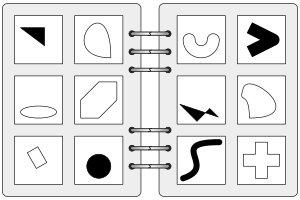Bongard problem facts for kids
A Bongard problem is a special kind of puzzle. It was created by a Russian computer scientist named Mikhail Moiseevich Bongard. He probably came up with these puzzles in the mid-1960s.
Bongard problems were first shared in his 1967 book. This book was about how computers can learn to recognize patterns. The main goal of a Bongard problem is to find a hidden rule. You need to spot the difference between two groups of pictures.
What Are Bongard Problems?
Bongard problems show you two sets of simple drawings. Let's call them Set A and Set B. All the drawings in Set A share something in common. This common feature is missing from all the drawings in Set B.
Your job is to figure out this secret rule or common factor. It's like being a detective for shapes and patterns!
Why Are They Important?
These puzzles became very popular because of a book called Gödel, Escher, Bach. This book was written in 1979 by Douglas Hofstadter. He also creates his own Bongard problems.
Hofstadter believes that solving these puzzles is very close to "pure" intelligence. It helps you think about how we recognize patterns. Bongard problems are also a key part of a game called Zendo. This shows how useful they are for understanding how our minds work.


